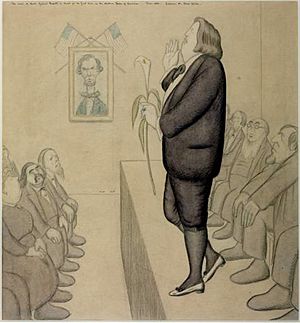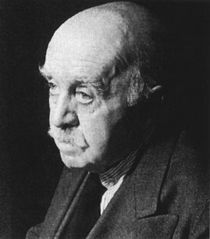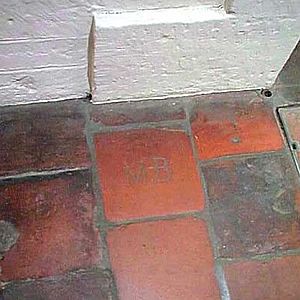Max Beerbohm facts for kids
Quick facts for kids
Max Beerbohm
|
|
|---|---|
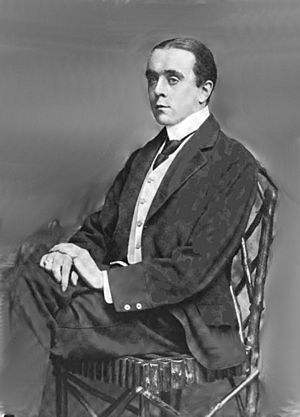
From The Critic 1901
|
|
| Born | Henry Maximilian Beerbohm 24 August 1872 London, England |
| Died | 20 May 1956 (aged 83) Rapallo, Italy |
| Resting place | St. Paul's Cathedral |
| Occupation | Essayist, parodist, caricaturist |
Sir Henry Maximilian Beerbohm (born August 24, 1872 – died May 20, 1956) was a famous English writer and artist. He was known for his essays, his funny parodies of other writers, and his clever caricatures (exaggerated drawings of people). He often signed his work simply as Max.
Max first became well-known in the 1890s as a stylish person (a dandy) and a humorist. He worked as a drama critic for the Saturday Review newspaper from 1898 to 1910. After that, he moved to Rapallo, Italy. Later in his life, he became very popular for his talks on the radio. One of his most famous works is his only novel, Zuleika Dobson, published in 1911. His caricatures, usually drawn with pen or pencil and light watercolors, are now in many public art collections.
Contents
Early Life and Education

Henry Maximilian Beerbohm was born in London, England, on August 24, 1872. He was the youngest of nine children. His father, Julius Ewald Edward Beerbohm, was a grain merchant from Lithuania. Max's mother was Eliza Draper Beerbohm.
Max was very close to his older half-siblings. One of them, Herbert Beerbohm Tree, was already a famous stage actor when Max was a child. Other siblings included the author and explorer Julius Beerbohm and the author Constance Beerbohm.
From 1881 to 1885, Max attended a day school in Orme Square. He later said that his teacher, Mr. Wilkinson, helped him love Latin, which in turn helped him write English well. Mrs. Wilkinson taught drawing, which were the only drawing lessons Max ever had.
Max went to Charterhouse School and then Merton College, Oxford, starting in 1890. He began writing while he was still at school. At Oxford, he met Oscar Wilde and his friends through his half-brother, Herbert Beerbohm Tree. In 1893, he also met William Rothenstein, who introduced him to other artists and writers.
Even though he wasn't a very serious student, Max became popular in Oxford's social scene. He started sending his articles and caricatures to magazines in London, and people really liked them. He once joked, "I was a modest, good-humoured boy. It was Oxford that has made me insufferable." By 1894, Max had developed his unique style as a dandy and humorist. He left Oxford without a degree but was already a rising star in English writing.
Becoming a Writer and Broadcaster
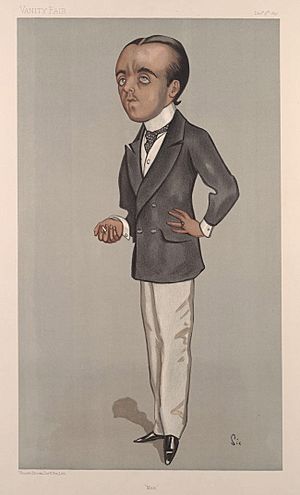
When Max Beerbohm returned to England, he published his first book in 1896. It was called The Works of Max Beerbohm and was a collection of his essays. His first story, The Happy Hypocrite, was published in 1896.
In 1898, Max took over from George Bernard Shaw as the drama critic for the Saturday Review. He stayed in this job until 1910. George Bernard Shaw famously called him "the Incomparable Max" in his last article for the newspaper.
In 1904, Beerbohm met an American actress named Florence Kahn. They got married in 1910 and moved to Rapallo, Italy. They wanted to escape the busy social life and high costs of living in London. They lived in Rapallo for the rest of their lives, except when they returned to Britain during World War I and World War II. They also made occasional trips to England for his art exhibitions.
During World War I (1914-1918), Max and Florence stayed in a cottage in Gloucestershire, England. Even in the countryside during wartime, Max always looked perfectly neat and dressed up.
While living in Rapallo, many famous people visited Beerbohm. These visitors included writers like Ezra Pound, Somerset Maugham, and Truman Capote, as well as actors like John Gielgud and Laurence Olivier. Interestingly, Max never learned to speak Italian, even after living in Italy for 50 years.
From 1935 onwards, Max became a popular radio broadcaster for the BBC. He talked about various topics, including cars, carriages, and music halls. His radio talks were later published in a book called Mainly on the Air in 1946. His humor was clear in his drawings and his letters. He often gently made fun of the trends of his time.
Some of Max Beerbohm's most famous books include:
- A Christmas Garland (1912): A book of funny parodies of different writing styles.
- Seven Men (1919): This collection includes "Enoch Soames", a story about a poet who makes a deal with the Devil to find out how people will remember him in the future.
- Zuleika Dobson (1911): This was his only novel. It's a funny story about student life at Oxford. It was very successful.
Max as a Caricaturist
Max Beerbohm showed great talent for drawing people with keen observation when he was a student at Oxford University in the 1890s. His unique style of drawing single caricatures with pen or pencil and light watercolor tints became popular by 1896. He continued this style until about 1930. His drawings were light and simple, unlike the heavier styles of other artists at the time.
Max's career as a professional caricaturist began when he was twenty. In 1892, The Strand Magazine published 36 of his drawings called 'Club Types'. He said this publication was a "great, an almost mortal blow to my modesty," meaning it made him very famous. His first public art show was in 1896, and his first solo show was in 1901.
Max explained his approach to caricature: "The whole man must be melted down in a crucible and then, from the solution, fashioned anew." He believed the best caricature "most accurately exaggerates, to the highest point, the peculiarities of a human being."
Max was inspired by French cartoonists like "Sem" and "Caran d'Ache." In 1913, The Times newspaper called him "the greatest of English comic artists."
Beerbohm was especially good at drawing heads and the fancy male clothing of his time. This elegance became a source of inspiration for him. His collections of caricatures include:
- Caricatures of Twenty-five Gentlemen (1896)
- The Poets' Corner (1904)
- Fifty Caricatures (1913)
- Rossetti and His Circle (1922)
His caricatures were published in popular magazines and shown regularly in London art galleries. At his home in Rapallo, he drew and wrote less often. He also decorated books in his personal library. These books were later sold at an auction in London after his second wife passed away.
Many of his later caricatures, especially those drawn in Rapallo, were of himself. He also drew many political, literary, and theater figures from the late Victorian and Edwardian times. The court of King Edward VII was a favorite subject for his playful drawings.
Major collections of Max Beerbohm's caricatures can be found in several museums and libraries. These include the Ashmolean Museum in Oxford, the Tate collection, and the Victoria and Albert Museum.
Later Life and Legacy
Max Beerbohm was knighted by King George VI in 1939. This honor was perhaps delayed because he had made fun of the king's parents in a satiric poem in 1911.
In August 1942, on his 70th birthday, a group called the Maximilian Society was created in London to honor him. It had 70 famous members, including writers like J. B. Priestley and E. M. Forster, and artists like Augustus John. The society planned to add one new member each year on Max's birthday. At their first meeting, they held a banquet for him and gave him 70 bottles of wine.
Max Beerbohm died in Rapallo, Italy, on May 20, 1956, at the age of 83. He passed away shortly after marrying his secretary and companion, Elisabeth Jungmann. His body was cremated in Genoa, and his ashes were placed in the crypt of St. Paul's Cathedral in London on June 29, 1956.
See also
 In Spanish: Max Beerbohm para niños
In Spanish: Max Beerbohm para niños
- Beerbohm family




